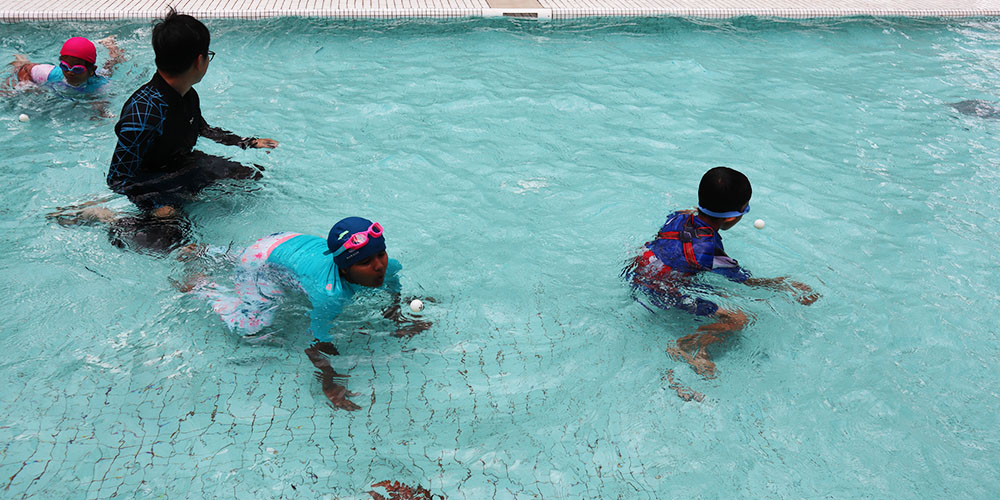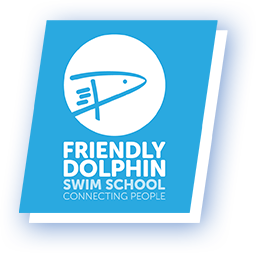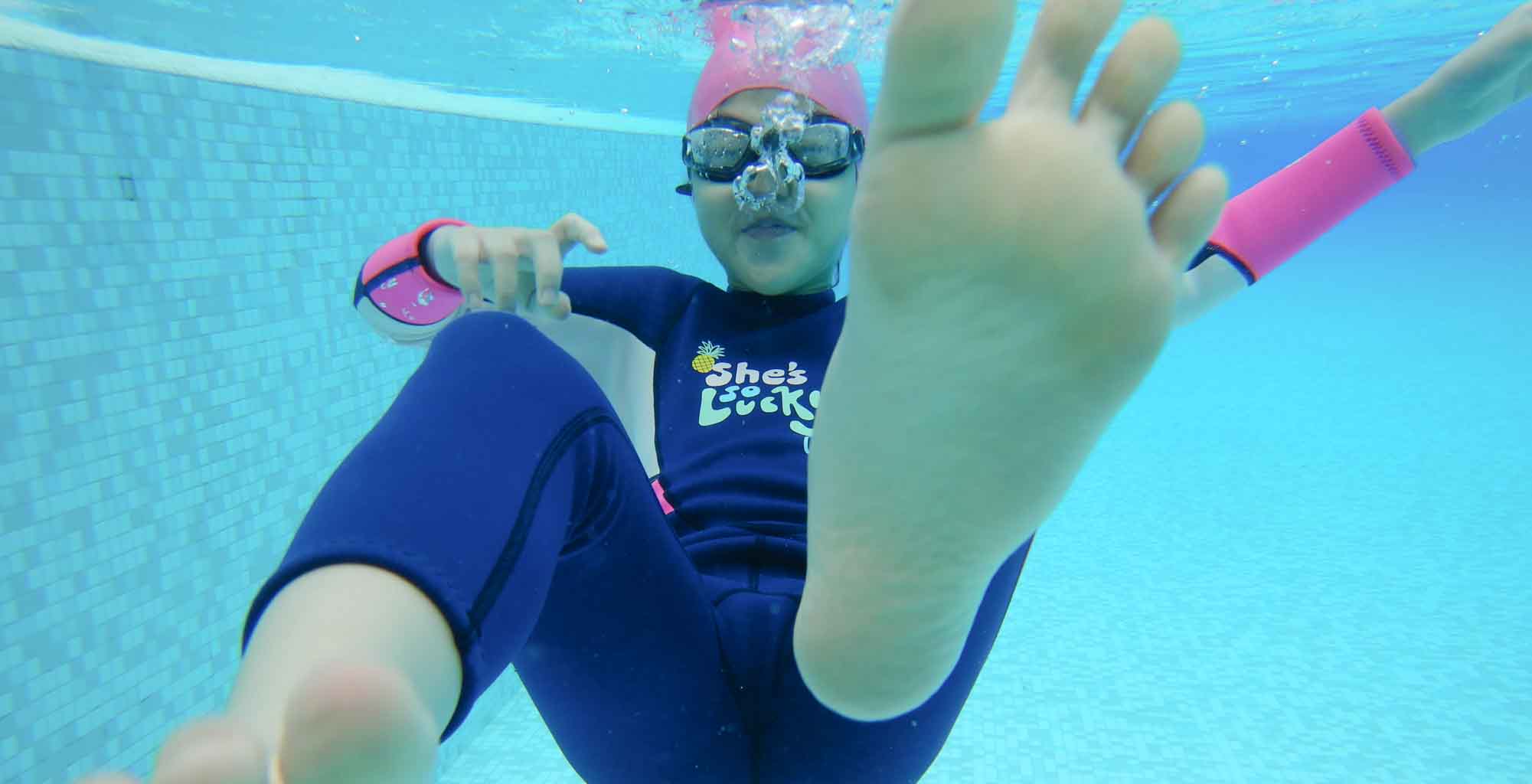
Learn in shallow water first before tackling deep water.
Deepwater – A person in deep water means that the water is higher than their chest.
Shallow water – refers to regions of a swimming pool with water less than 5 feet deep or lesser. The term “shallow water” refers to water at or below the height of the person’s chest.
Everyone who wants to swim more efficiently always starts learning how to swim in deep water. The following will help you understand how I work. However, before going into the deep end, learn to swim in shallow water. Learning in shallow water first will help in overcoming fear and fear of water better.
There are a lot of different places where people can learn new things about driving, like at a place called “spaghetti junction.” It wouldn’t happen that way.
Make sure that you are entirely at ease with the water before getting to the deep water; this is very important. You must be able to use the water effectively to avoid wriggling around in it.
To begin, learn to swim in shallow water. Then, take a dip in the deep end. You may have had a swimming stroke, but we need to understand how the water interacts with your body to improve it. You and the water are not a good match. Before you try to swim in the deep water, you need to learn a few things.
The best way to teach people who are afraid to swim is to use shallow water where they can stand. In this case, the child feels safe and in charge as they move through the water familiarisation stage independently.
The shallow water also allows the swimmers to practice for as long as possible. These give the swimming teacher advantages and you don’t have to take each child one at a time. You can move all the kids together as a group.
Studies show that deep and shallow water have different effects on how well preschoolers learn how to swim.
The study’s goal was to look at how preschoolers learned basic swimming skills through lessons in both deep and shallow water.
There were 32 swimming instructors and 98 preschoolers who took part in the study. 16 worked in deep water, and 16 worked in shallow water (50 from deep water swimming pools and 48 from the shallow water swimming pool).
The children were also looked at in terms of how they had previously swum (6, 12, and 18 months of practice). The Chi-Square test and Fisher’s exact test were used to compare how people were taught. Discriminant analysis was done with Wilk’s method to determine when students are better or worse (aquatic competence).
Results show that even though there aren’t any big differences in teaching methods, the depth of the water can affect how well you learn to swim.
After six months of practice, lessons in shallow water seem to make you more water-savvy. In addition, the discriminant function found that there was a strong connection between groups and all predictors for six months of swimming practice (p0.001).
Body position in gliding and the movement of the legs were the main predictors of how well you did. For 12 and 18 months of practice, the discriminant function didn’t show that there was a big difference between groups. As a result, it doesn’t look like preschoolers learn about aquatic readiness through programs in deep and shallow water is very different from how adults do it.
However, shallow water lessons might be better for learning how to swim.
There were two main goals for this study. The first one was to describe the differences in how aquatic readiness is taught in deep and shallow water programs for preschool kids.
The findings show no big differences between the two ways of teaching.
After six, 12, and 18 months of practice, deep and shallow water students were compared. The second main goal was to see any differences in aquatic readiness between the two groups.
In this case, the discriminant function analysis found that both groups and all of the predictors (aquatic skills) were linked for only six months of swimming practice.
On the other hand, the shallow-water students seem to be better at a lot of things in the water even after just a year of practice.
Deep-water programs for preschoolers might need to be carefully planned to learn basic skills that aren’t as strong because of the setting. For example, one of the skills that deep-water students have a hard time with is how they move their bodies while gliding.
More willing to try new things
In shallow water, when you get a student over their fear of getting their head underwater, they are far more willing to try new things in the water than they are in deep water. This is true, especially for people who want to swim. People who have been afraid of water for a long time usually have a lot of fear. It is very empowering as long as you know that you can stand up even if things go wrong.
It’s only when you can make a new student feel safe that the deep and shallow water are the same thing. Every swimming student has to move on to deeper water at some point in their lives. Otherwise, their skills won’t get any better. Therefore, it is crucial to learn to feel safe when you can’t touch the bottom of the pool or the sea.
Research & Results
One in-depth study was conducted to compare how preschoolers learned to swim in deep water and shallow water, as well as to find out if there were any differences in the basic skills they learned.
32 swimming instructors (16 from deep water programs and 16 from shallow water programs) and 98 preschoolers made up the study’s sample (50 from deep water swimming pools and 48 from shallow water swimming pools). The children were also asked about how much swimming experience they had (6, 12, and 18 months of practice).
To compare the ways of teaching, the Chi-Square test and Fisher’s exact test were used. Wilk’s method was used to do a discriminant analysis to find out what makes students better or worse (aquatic competence).
Even though the differences in teaching methods weren’t very big, the results show that the depth of the water can affect how well people learn to swim. After 6 months of practice, shallow water lessons seem to make people better at swimming. For 6 months of swimming practice, the discriminant function showed that there was a strong link between groups and all predictors (p0.001).
The main predictors were how the body moved while gliding and how the legs moved. After 12 and 18 months of practice, the discriminant function hasn’t found any big differences between the groups.
In conclusion, it seems that the way preschoolers are taught to be ready to swim in both deep and shallow water programs is not very different.
But lessons in shallow water might be better for learning the basics of how to swim.
Conclusion
People who are just learning to swim often learn faster and with more confidence in shallow water than in deep water; swimming instructors provide them with guidance and a lot of practice, and encouragement, and teaching students in deeper water should be no problem.
However, only shallow water will be the better option due to students’ fear.
I’ve worked at many swimming pools over the years, and I’ve had a lot of chances to see both the advantages and disadvantages of both learning in shallow water and deep water. However, I have to say that I prefer to teach children to swim in shallow water.
In my opinion, most swimmers will improve and swim faster in deeper water after they get through the first stages of learning to swim. There is no doubt that learning to swim is easier when you can touch the bottom. You must be safe in that deep water. You must have an instructor or someone else who knows what they are doing enough to keep you safe.
Table 1
Teacher’s responses about the purpose of their aquatic readiness lessons
| Shallow water instrutors (n=16) | Deep water instructors (n=16) | p-value | |||
|---|---|---|---|---|---|
| Agree | Not Agree | Agree | Not Agree | ||
| Water survival | 14 (87,50%) | 2 (25,0%) | 15 (93,75%) | 1 (6,25%) | 1.0 |
| Learning to swim | 9 (56,25%) | 7 (43,75%) | 14 (87,75%) | 2(12,5%) | 0.11 |
| Not fear the water | 12 (75,0%) | 4 (25,0%) | 15 (93,75%) | 1 (6,25%) | 0.33 |
| Swimming for fun | 16 (100,0%) | 0 (0%) | 16 (100,0%) | 0 (0,0%) | 1.0 |
| To develop future swimmers | 1 (6,25%) | 15 (93,75%) | 5 (31,25%) | 11 (68,75%) | 0.17 |
Table 2
Teacher’s responses about the use of support material and the contents applied in shallow and deep water
| Material | Shallow water instrutors (n=16) | Deep water instructors (n=16) | ||||||
|---|---|---|---|---|---|---|---|---|
| Always | Sometimes | Rarely | Never | Always | Sometimes | Rarely | Never | |
| None | 1 (6,25%) | 6 (37,5%) | 5 (31,25%) | 4 (25,0%) | 0 (0,0%) | 9 (56,25%) | 5 (31,25%) | 2 (12,50%) |
| Swimming Board | 3 (18,75%) | 12 (75,0%) | 1 (6,25%) | 0 (0,0%) | 4 (25,0%) | 12 (75,0%) | 0 (0,0%) | 0 (0,0%) |
| Arm Band | 0 (0,0%) | 2 (12,5%) | 4 (25,0%) | 10 (62,25%) | 1 (6,25%) | 6 (37,5%) | 2 (12,5%) | 7 (43,75%) |
| Floating Tube | 3 (18,75%) | 11 (68,5%) | 0 (0,0%) | 2 (12,5%) | 4 (25,0%) | 12 (75,0%) | 0 (0,0%) | 0 (0,0%) |
| Sinking Toys | 3 (18,75%) | 11 (68,5%) | 1 (6,25%) | 1 (6,25%) | 2 (12,5%) | 13 (81,25%) | 1 (6,25%) | 0 (0,0%) |
| Others | 3 (18,75%) | 9(56,25%) | 3 (18,75%) | 1(6,25%) | 2 (12,5%) | 12 (75,0%) | 0 (0,0%) | 2 (12,5%) |
| Skills | ||||||||
| Water entry | 13 (81,25%) | 3 (18,75%) | 0 (0,0%) | 0 (0,0%) | 10 (62,5%) | 6 (37,5%) | 1 (6,25%) | 0 (0,0%) |
| Confidence & Security | 14 (87,5%) | 2 (12,5%) | 0 (0,0%) | 0 (0,0%) | 13 (81,25%) | 2 (12,5%) | 0 (0,0%) | 1(6,25%) |
| Imersion | 8 (50,0%) | 3 (18,75%) | 0 (0,0%) | 0 (0,0%) | 8 (50,0%) | 8 (50,0%) | 5 (31,25%) | 0 (0,0%) |
| Balance | 12 (75,0%) | 4 (25,0%) | 0 (0,0%) | 0 (0,0%) | 10 (62,5%) | 6 (37,5%) | 0 (0,0%) | 0 (0,0%) |
| Legs displacement | 10 (62,5%) | 4 (25,0%) | 2 (12,5%) | 0 (0,0%) | 14 (87,5%) | 2 (12,5%) | 0 (0,0%) | 0 (0,0%) |
| Arms & legs displacement | 3 (18,75%) | 7 (43,75%) | 6 (37,5%) | 0 (0,0%) | 9 (56,25%) | 5 (31,25%) | 2 (12,5%) | 0 (0,0%) |
| Glide | 13 (81,25%) | 2 (12,5%) | 1 (6,25%) | 0 (0,0%) | 5 (31,25%) | 11 (68,5%) | 0 (0,0%) | 0 (0,0%) |
| Rotations | 3 (18,75%) | 11 (68,5%) | 2 (12,5%) | 0 (0,0%) | 2 (12,5%) | 12 (75,0%) | 2 (12,5%) | 0 (0,0%) |
| Basics | 7 (43,75%) | 6 (37,5%) | 2 (12,5%) | 1 (6,25%) | 8 (50,0%) | 8 (50,0%) | 0 (0,0%) | 0 (0,0%) |
| Dives | 11 (68,5%) | 4 (25,0%) | 2 (12,5%) | 0 (0,0%) | 9 (56,25%) | 7 (43,75%) | 0 (0,0%) | 0 (0,0%) |
| Breath control | 16 (100,0%) | 0 (0,0%) | 0 (0,0%) | 0 (0,0%) | 9 (56,25%) | 7 (43,5%) | 0 (0,0%) | 0 (0,0%) |
| Depth imersions | 0 (0,0%) | 10 (62,5%) | 1 (6,25%) | 1 (6,25%) | 9 (56,25%) | 7 (43,75%) | 0 (0,0%) | 0 (0,0%) |
Table 3
Aquatic skills acquired (Mean ± SD) by shallow-water and deep-water students after 6, 12 and 18 months of practice
| 6 months of practice | 12 months of practice | 18 months of practice | ||||||||
|---|---|---|---|---|---|---|---|---|---|---|
| Skill | Levels of complexity | Shallow-water | Deep-water | p-value | Shallow-water | Deep-water | p-value | Shallow-water | Deep-water | p |
| Mean ± SD | Mean ± SD | Mean ± SD | Mean ± SD | Mean ± SD | Mean ± SD | |||||
| Sk1 | 1 to 3 | 3,00±0,00 | 2,63±0,50 | .005 * | 3,00±0,00 | 2,88±0,34 | .154 | 3,00±0,00 | 3,00±0,00 | |
| Sk2 | 1 to 3 | 2,88±0,34 | 2,63±0,50 | .109 | 2,75±0,45 | 2,75±0,45 | 1.000 | 2,89±0,32 | 2,88±0,34 | .904 |
| Sk3 | 1 to 5 | 4,38±0,89 | 4,06±0,93 | .338 | 4,06±1,06 | 4,31±0,95 | .488 | 4,33±0,91 | 4,56±0,81 | .446 |
| Sk4 | 1 to 4 | 3,13±1,03 | 1,38±0,72 | .000 * | 2,63±1,09 | 1,75±0,86 | .017 * | 3,11±0,96 | 2,69±1,20 | .261 |
| Sk5 | 1 to 4 | 3,50±0,82 | 1,50±0,89 | .000 * | 2,88±1,09 | 2,19±1,38 | .128 | 3,39±0,85 | 2,81±1,17 | .107 |
| Sk6 | 1 to 4 | 2,88±1,20 | 1,00±0,00 | .000 * | 2,69±1,25 | 1,63±1,03 | .013 * | 2,83±1,25 | 2,13±1,26 | .110 |
| Sk7 | 1 to 3 | 1,94±0,57 | 1,06±0,25 | .000 * | 1,94±0,68 | 1,31±0,48 | .005 * | 2,00±0,59 | 1,81±0,75 | .423 |
| Sk8 | 1 to 4 | 1,94±1,24 | 1,06±0,25 | .009 * | 1,44±0,81 | 1,13±0,50 | .201 | 1,89±1,18 | 1,50±0,97 | .305 |
| Sk9 | 1 to 4 | 2,88±0,89 | 1,44±0,51 | .000 * | 2,63±1,09 | 2,13±0,81 | .150 | 2,94±0,87 | 2,81±0,91 | .669 |
| Sk10 | 1 to 4 | 2,63±0,81 | 1,31±0,48 | .000 * | 2,56±0,96 | 1,81±0,75 | .020 * | 2,67±0,84 | 2,31±0,87 | .237 |
| Sk11 | 1 to 4 | 2,38±0,62 | 1,25±0,45 | .000 * | 2,44±1,21 | 2,06±0,93 | .333 | 2,44±0,62 | 2,44±0,89 | .979 |
| Sk12 | 1 to 4 | 2,25±0,78 | 1,06±0,25 | .000 * | 2,31±1,08 | 1,44±0,63 | .009 * | 2,33±0,84 | 2,31±1,08 | .950 |
| Sk13 | 1 to 3 | 2,69±0,60 | 2,13±0,62 | .014 * | 2,63±0,50 | 2,31±0,48 | .081 | 2,72±0,58 | 2,56±0,51 | .401 |
| Sk14 | 1 to 3 | 2,44±0,51 | 1,69±0,79 | .003 * | 2,44±0,51 | 2,19±0,75 | .280 | 2,44±0,51 | 2,50±0,63 | .779 |
| Sk15 | 1 to 3 | 2,19±0,83 | 1,75±0,68 | .115 | 1,63±0,81 | 2,19±0,54 | .028 * | 2,28±0,83 | 2,63±0,62 | .180 |
| Sk16 | 1 to 5 | 3,06±1,48 | 1,44±0,96 | .001 * | 2,75±1,48 | 2,88±1,86 | .835 | 3,28±1,53 | 3,19±1,72 | .872 |
| Sk17 | 1 to 4 | 2,75±1,18 | 1,38±0,72 | .000 * | 1,81±1,05 | 2,25±1,65 | .378 | 2,89±1,18 | 2,56±1,32 | .452 |
Table 4.1
Structure matrix for shallow-water and deep-water students after 6, 12 and 18 months of practice
| 6 months of practice | 12 months of practice | 18 months of practice | |||
|---|---|---|---|---|---|
| Predictors | Function | Predictors | Function | Predictors | Function |
| Sk5 | .467 | Sk7 | .444 | Sk5 | .286 |
| Sk6 | .441 | Sk12 | .414 | Sk6 | .284 |
| Sk11 | .417 | Sk6 | .388 | Sk15 | −.237 |
| Sk12 | .413 | Sk4 | .373 | Sk10 | .208 |
| Sk9 | .398 | Sk10 | .363 | Sk4 | .197 |
| Sk10 | .396 | Sk15 | −.342 | Sk8 | .180 |
| Sk7 | .396 | Sk13 | .267 | Sk13 | .147 |
| Sk4 | .396 | Sk5 | .231 | Sk7 | .140 |
| Sk17 | .281 | Sk9 | .218 | Sk3 | −.133 |
| Sk16 | .260 | Sk1 | .216 | Sk17 | .131 |
| Sk14 | .225 | Sk8 | .193 | SK9 | .074 |
| Sk1 | .212 | Sk14 | .163 | Sk14 | −.049 |
| Sk8 | .196 | Sk11 | .145 | Sk16 | .028 |
| Sk13 | .184 | Sk17 | −.132 | Sk2 | .021 |
| Sk2 | .117 | Sk3 | −.104 | Sk12 | .011 |
| Sk15 | .115 | Sk16 | −.031 | Sk11 | .005 |
| Sk3 | .069 | Sk2 | .000 | ||
Pooled within-groups correlations between discriminating variables and standardized canonical discriminant functions. Variables are ordered by the absolute size of correlation within the function.
Table 4.2
Functions at Group Centroids for shallow-water and deep-water students after 6, 12 and 18 months of practice
| 6 months of practice | 12 months of practice | 18 months of practice | |
|---|---|---|---|
| Context of practice | Function | Function | Function |
| Deep-water | −2.499 | −1.197 | −1.055 |
| Shallow-water | 2.499 | 1.197 | .938 |
Unstandardized canonical discriminant functions evaluated at group means.


